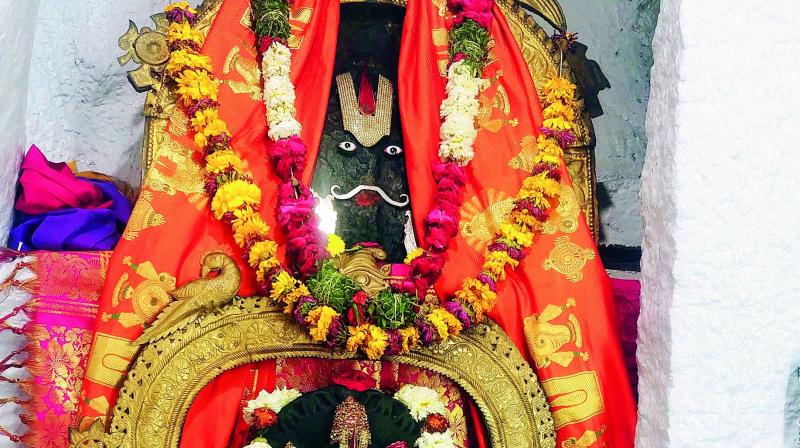Chennakesava reigns at Chandrayangutta

Hyderabad: It stands tall and elegant, right in the midst of chaos called Chandrayangutta, a hectic junction in one of the suburbs of Hyderabad’s Old City. In fact one of the landmarks to reach this temple is the elegant Falaknuma Palace, right behind the temple. Once you locate the temple you have to climb around 100 steps to get to it. With no railing to hang on to, this can be a bit hazardous, but the gentle breeze that springs up, the small houses with potted plants you see along the way and the clean and green environs make it a pleasant journey.
Once you reach the top, there are steps that lead to a blue-coloured wooden gate, which is the entrance to a Lord Shiva temple. If you miss the blue gate, you have to jump over rocks to reach an open area leading to the main temple. The main temple houses the presiding deity of Lord Chennakesava, apparently the first name of Lord Krishna, where the deity sports a handsome silver moustache. The garbhagriha of the Swayambhu Chennakesava Swamy faces a 28-pillared mandapa. The temple has two entrances, on the north and south sides. The sounds of traffic are quite loud but it is still mesmeric, with a gentle breeze blowing and a 360-degree view of the city.
“If care is taken of it this temple can become as important as Tirumala temple,” says Pranayacharya, the temple priest. “We have the same pujas which are conducted at the Yadadri temple, but that temple is much larger and more popular.” The crowds come during Vaikunta Ekadasi day and during the ten days of Brahmotsavams. Rajendra, the Gudimalkapur ward president and Anil, the chairman of the temple committee and other members are actively involved in collection of funds for the temple.
Pranayacharya, dressed in his priestly silks, is all of 23, and and M Com graduate. He is on duty because his father, Pratapacharya, the main priest at the temple was indisposed. Pranayacharya also conducts pujas at a nearby Durga temple. The temple is built of rock and granite. The Swayambhu idol is of granite but in recent times it has been protected and there is yet another smaller idol kept before it. The temple gets a coat of whitewash at the time of Brahmotsavam, which happened here recently, but otherwise money is in short supply.
The temple has been under the Endowments department for the past two years, but does not seem to have benefitted from this. There is no water for devotees to wash their feet after climbing the steps, nor are there any other facilities like a hand rail alongside the flight of steps or a protective railing surrounding the temple. Recently, the old dharamshala collapsed and slid down the hillock endangering the lives of those living there.
The priest’s family live in houses built by the department of archaeology - the old rooms within the temple were crumbling and in total disrepair. In fact, even now you are not allowed very close to this area in the temple for fear of falling stones and beams. “It is risky living like this, especially during the monsoon and when there is lightning and gales,” says Pranayacharya. Much of the old temple is much as it has been all these years, except for a steel railing within the temple sanctum to mark a queue system during Vaikuntha Ekadishi celebrations, and bright orange paint on the wooden doors of the sanctum sanctorum and granite pillars to which they are attached.
While Lord Ranganatha lies in grace above the entrance to the sanctum, inside stands the Swayambhu statue of Chennakesava. While there is no clarity on the provenance of the temple, the architecture points to a time when there was no influence of any particular style. And of course there is a king with a dream here too. The king dreamt that there was an idol on the hillock and a temple should thus be built there. And thus it came to be. And since climbing up was not possible every day, he built a bungalow opposite the temple and he and his family would worship from there, says a legend.
The bungalow is now suitably called ‘Darshan Bungalow’. It is now in shambles. The other unique feature of this temple is the Swayambhu Chaturbhuja (four-armed) Lord Hanuman, who stands guard over the main idol. Most of the trees have been cut for safety reasons, but not the Marri Chattu, thanks to the Swayambhu Ganesha. Devotees worship this famous Ganesh Vruksham, thanks to a branch which looks like the elephant god and has been painted orange to highlight its natural shape. This temple is also a Hari Hara Kshetra because it houses both Lord Shiva as Ramalingeshwara and Lord Vishnu as Chenna Kesava. In fact, Shivaratri is also celebrated with great pomp, according to the priest. There are sub-temples dedicated to Andal and the Alwars.

